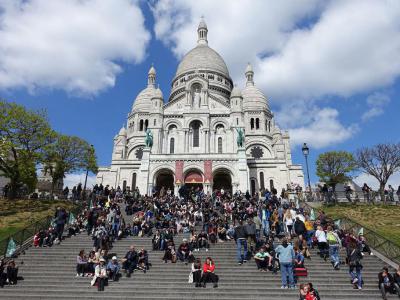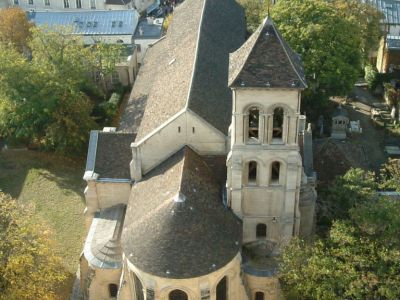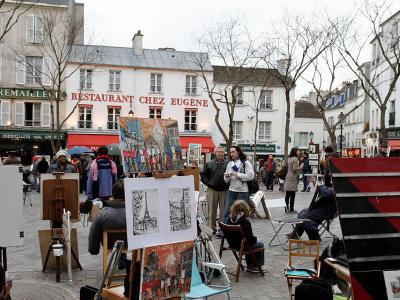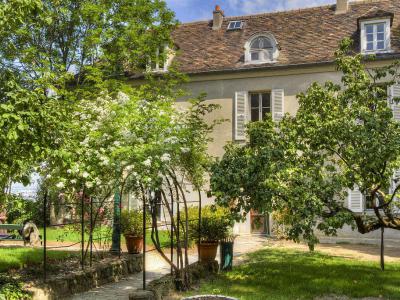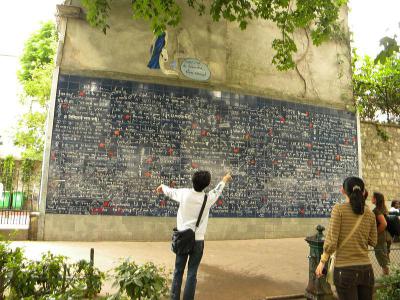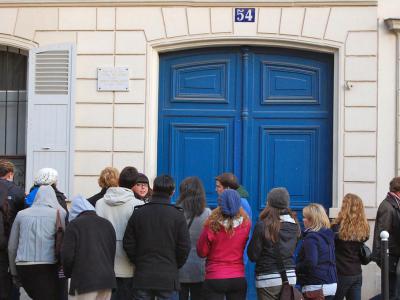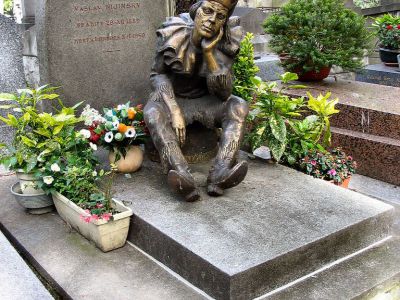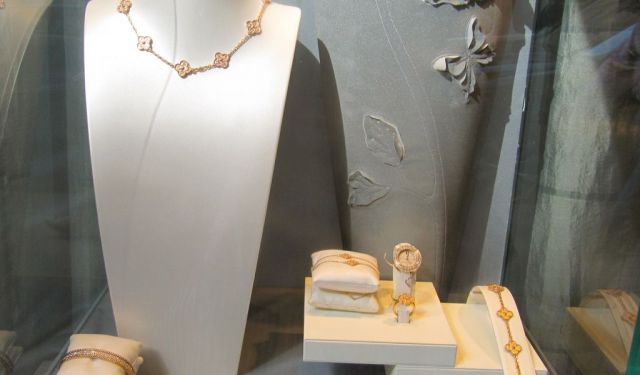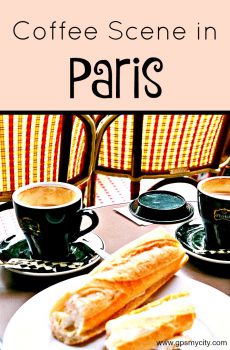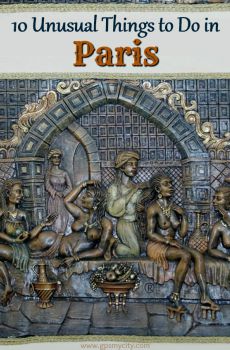
Montmartre Walking Tour (Self Guided), Paris
Originally known as "Mons Martis" or the "Mount of Mars," Montmartre is a renowned Parisian neighborhood, celebrated for its historical and cultural significance. This picturesque district is a canvas of landmarks, each narrating a unique story.
Apart from its iconic sites, the area's charm lies in the atmosphere that embodies the Parisian spirit. Historically, Montmartre has been a hub for artists, hosting luminaries such as Claude Monet, Auguste Renoir, Vincent Van Gogh, Pablo Picasso, and Salvador Dali, and it continues to uphold the tradition of fostering art, culture, and a bohemian lifestyle.
A visit to Montmartre is incomplete without experiencing the Sacred Heart Basilica. Perched atop a hill, this dazzling white temple is a sight to behold and offers panoramic views of Paris. Nearby, the Church of Saint-Pierre de Montmartre, dating back to the 12th century, presents a fascinating architectural contrast; it houses a Roman-built column, underscoring its historical depth.
For art enthusiasts, the Montmartre Museum and the Dali Paris Museum are essential stops. The former, located in a building that once housed famous artists such as Auguste Renoir and Suzanne Valadon, showcases exhibitions on the area's history and the evolution of cabaret. As for the Dali Museum, it provides insights into the life and works of Salvador Dali in the French capital through a collection of his surreal artworks.
Meanwhile, the vibrant Tertre Square, packed to the brim with artists and spectators, epitomizes Montmartre's ongoing artistic legacy. Here, visitors can immerse themselves in the neighborhood's creative atmosphere. Other notable attractions featured in this walk include the picturesque Agile Rabbit Cabaret, which offers a glimpse into the bohemian lifestyle of the past, and the historic Galette Windmill captured in several Renoir paintings.
Further enriching the cultural tapestry of Montmartre are the Wall of Love, with the phrase 'I love you' inscribed in over 250 languages, and Lepic Street, the former residence of Van Gogh.
The Montmartre Cemetery, with its serene ambiance and ornate stone angels, provides a stark contrast to the bustling streets, serving as the final resting place for notable French individuals like the impressionist artist Degas, writer Stendhal, and pop diva Dalida.
At the district's base, the world-renowned Moulin Rouge cabaret continues to dazzle with its shows, drawing visitors from far and away.
For those yearning to experience the blend of history, art, and romance, Montmartre awaits. To ensure a truly memorable experience, consider following this self-guided walking tour through the bohemian rhapsody that continues to captivate hearts and inspire minds.
Apart from its iconic sites, the area's charm lies in the atmosphere that embodies the Parisian spirit. Historically, Montmartre has been a hub for artists, hosting luminaries such as Claude Monet, Auguste Renoir, Vincent Van Gogh, Pablo Picasso, and Salvador Dali, and it continues to uphold the tradition of fostering art, culture, and a bohemian lifestyle.
A visit to Montmartre is incomplete without experiencing the Sacred Heart Basilica. Perched atop a hill, this dazzling white temple is a sight to behold and offers panoramic views of Paris. Nearby, the Church of Saint-Pierre de Montmartre, dating back to the 12th century, presents a fascinating architectural contrast; it houses a Roman-built column, underscoring its historical depth.
For art enthusiasts, the Montmartre Museum and the Dali Paris Museum are essential stops. The former, located in a building that once housed famous artists such as Auguste Renoir and Suzanne Valadon, showcases exhibitions on the area's history and the evolution of cabaret. As for the Dali Museum, it provides insights into the life and works of Salvador Dali in the French capital through a collection of his surreal artworks.
Meanwhile, the vibrant Tertre Square, packed to the brim with artists and spectators, epitomizes Montmartre's ongoing artistic legacy. Here, visitors can immerse themselves in the neighborhood's creative atmosphere. Other notable attractions featured in this walk include the picturesque Agile Rabbit Cabaret, which offers a glimpse into the bohemian lifestyle of the past, and the historic Galette Windmill captured in several Renoir paintings.
Further enriching the cultural tapestry of Montmartre are the Wall of Love, with the phrase 'I love you' inscribed in over 250 languages, and Lepic Street, the former residence of Van Gogh.
The Montmartre Cemetery, with its serene ambiance and ornate stone angels, provides a stark contrast to the bustling streets, serving as the final resting place for notable French individuals like the impressionist artist Degas, writer Stendhal, and pop diva Dalida.
At the district's base, the world-renowned Moulin Rouge cabaret continues to dazzle with its shows, drawing visitors from far and away.
For those yearning to experience the blend of history, art, and romance, Montmartre awaits. To ensure a truly memorable experience, consider following this self-guided walking tour through the bohemian rhapsody that continues to captivate hearts and inspire minds.
How it works: Download the app "GPSmyCity: Walks in 1K+ Cities" from Apple App Store or Google Play Store to your mobile phone or tablet. The app turns your mobile device into a personal tour guide and its built-in GPS navigation functions guide you from one tour stop to next. The app works offline, so no data plan is needed when traveling abroad.
Montmartre Walking Tour Map
Guide Name: Montmartre Walking Tour
Guide Location: France » Paris (See other walking tours in Paris)
Guide Type: Self-guided Walking Tour (Sightseeing)
# of Attractions: 12
Tour Duration: 2 Hour(s)
Travel Distance: 2.7 Km or 1.7 Miles
Author: karen
Sight(s) Featured in This Guide:
Guide Location: France » Paris (See other walking tours in Paris)
Guide Type: Self-guided Walking Tour (Sightseeing)
# of Attractions: 12
Tour Duration: 2 Hour(s)
Travel Distance: 2.7 Km or 1.7 Miles
Author: karen
Sight(s) Featured in This Guide:
- Basilique du Sacre-Coeur (Basilica of the Sacred Heart of Jesus)
- Eglise Saint-Pierre de Montmartre (Church of St. Peter at Montmartre)
- Place du Tertre (Tetre Square)
- Dali Paris (Espace Dali)
- Musee de Montmartre (Montmartre Museum)
- Cabaret Au Lapin Agile (Agile Rabbit Cabaret)
- Moulin de la Galette (Galette Windmill)
- Le Bateau-Lavoir – Picasso's Old Studio
- Le Mur des Je t'aime (Wall of Love)
- Rue Lepic (Lepic Street) and Van Gogh's Apartment
- Cimetiere de Montmartre (Montmartre Cemetery)
- Moulin Rouge (The Red Mill)
1) Basilique du Sacre-Coeur (Basilica of the Sacred Heart of Jesus) (must see)
The Basilica of the Sacred Heart of Montmartre is a Catholic church and a national historic monument since 2022. The imposing structure sits atop the Montmartre summit – the highest point in Paris (some 200 meters above the Seine). It offers a breathtaking panorama of the city from its dome, which makes it the second most-visited tourist site in the capital after the Eiffel Tower.
The idea to build the basilica came in the aftermath of the Franco-Prussian War of 1870-1871 (resulting in a humiliating defeat for France), followed by the brief and bloody Paris Commune period. Many in France, particularly conservative Catholics, viewed these events as moral failures of the nation. They believed it was a divine punishment for what they saw as the growing secularization and moral decay of French society in the decades following the French Revolution.
The new church was thus to symbolize national repentance. Its location at the highest point in Paris, however, made it a subject of controversy among left-wing politicians, as it overlooks the area where the Paris Commune erupted and was seen by some as a monument to conservative reactionism.
The construction spanned from 1875 to 1914 under the supervision of various architects. The basilica's consecration was delayed until the end of World War I, in 1919.
The building showcases a blend of Neo-Byzantine and Romanesque styles with a central rotunda, a nave, and transepts. The main dome rises 83 meters, flanked by four smaller cupolas and a bell tower that houses France’s largest bell, the Savoyarde. The rectangular base beneath the high dome is supported by massive columns as if bridging the celestial and terrestrial realms. The design incorporates a Greek cross layout centralizing the altar, surrounded by a Latin-influenced choir and ambulatory.
Artistic elements within the basilica include the grand 475-square-meter mosaic of The Triumph of the Sacred Heart of Jesus and various chapels adorned by specific professional groups, enhancing the spiritual ambiance with their thematic decorations. The crypt, unlike typical underground crypts, features stained glass windows that allow light to filter in, enriching the spiritual atmosphere. Also noteworthy is the basilica’s historic organ, recognized as a national landmark.
As a pilgrimage site, the basilica requires visitors to observe modest dress and silence out of respect for its sacredness and historical significance.
Tip:
You will need a level of fitness to climb the stairs from the base of Montmartre to the Sacred Heart Basilica. Alternatively, you can hop on the free mini-train which starts from opposite the Windmill Theater and stops behind the basilica.
The idea to build the basilica came in the aftermath of the Franco-Prussian War of 1870-1871 (resulting in a humiliating defeat for France), followed by the brief and bloody Paris Commune period. Many in France, particularly conservative Catholics, viewed these events as moral failures of the nation. They believed it was a divine punishment for what they saw as the growing secularization and moral decay of French society in the decades following the French Revolution.
The new church was thus to symbolize national repentance. Its location at the highest point in Paris, however, made it a subject of controversy among left-wing politicians, as it overlooks the area where the Paris Commune erupted and was seen by some as a monument to conservative reactionism.
The construction spanned from 1875 to 1914 under the supervision of various architects. The basilica's consecration was delayed until the end of World War I, in 1919.
The building showcases a blend of Neo-Byzantine and Romanesque styles with a central rotunda, a nave, and transepts. The main dome rises 83 meters, flanked by four smaller cupolas and a bell tower that houses France’s largest bell, the Savoyarde. The rectangular base beneath the high dome is supported by massive columns as if bridging the celestial and terrestrial realms. The design incorporates a Greek cross layout centralizing the altar, surrounded by a Latin-influenced choir and ambulatory.
Artistic elements within the basilica include the grand 475-square-meter mosaic of The Triumph of the Sacred Heart of Jesus and various chapels adorned by specific professional groups, enhancing the spiritual ambiance with their thematic decorations. The crypt, unlike typical underground crypts, features stained glass windows that allow light to filter in, enriching the spiritual atmosphere. Also noteworthy is the basilica’s historic organ, recognized as a national landmark.
As a pilgrimage site, the basilica requires visitors to observe modest dress and silence out of respect for its sacredness and historical significance.
Tip:
You will need a level of fitness to climb the stairs from the base of Montmartre to the Sacred Heart Basilica. Alternatively, you can hop on the free mini-train which starts from opposite the Windmill Theater and stops behind the basilica.
2) Eglise Saint-Pierre de Montmartre (Church of St. Peter at Montmartre)
Saint-Pierre de Montmartre is the second oldest surviving church in Paris, tracing its origins back to the 3rd century AD with foundations attributed to Saint Denis. The site, historically believed to have been a Temple of Mars, became a pilgrimage destination by the 9th century.
Officially established in 1133, the church formed the nucleus of the prestigious Montmartre Abbey, a site deeply intertwined with Parisian and religious history. After being reconsecrated in 1147, the church thrived under the patronage of French nobility up until the end of the 17th century. However, the French Revolution marked a period of decline, with the abbey's destruction and the church's desecration, temporarily transforming into a "Temple of Reason."
Post-Revolution, the church saw various uses, including a stint as a visual telegraph station and as barracks for Russian soldiers in 1814. Avoiding demolition, Saint-Pierre de Montmartre was eventually restored between 1899 and 1905 and formally returned to the religious service in 1908.
The church's hidden entry opens to a tree-filled courtyard, leading to a façade renovated in 1775 and adorned with modern bronze doorways added in 1980. These doors depict scenes from the lives of the Virgin Mary, Saint Peter, and Saint Denis of Paris. The interior showcases a Romanesque design with Gothic influences, featuring a nave with vaulted ceilings supported by intricately decorated pillars, a choir and apse with ancient elements, and unique Merovingian carvings.
Key artifacts within include the venerated statue of Our Lady of Montmartre, a Renaissance-style oval baptismal font from 1537, and a replica of the Vatican’s Saint Peter statue. The church also houses a historic organ, originally from Notre-Dame-de-Lorette, rebuilt in the 19th century.
Officially established in 1133, the church formed the nucleus of the prestigious Montmartre Abbey, a site deeply intertwined with Parisian and religious history. After being reconsecrated in 1147, the church thrived under the patronage of French nobility up until the end of the 17th century. However, the French Revolution marked a period of decline, with the abbey's destruction and the church's desecration, temporarily transforming into a "Temple of Reason."
Post-Revolution, the church saw various uses, including a stint as a visual telegraph station and as barracks for Russian soldiers in 1814. Avoiding demolition, Saint-Pierre de Montmartre was eventually restored between 1899 and 1905 and formally returned to the religious service in 1908.
The church's hidden entry opens to a tree-filled courtyard, leading to a façade renovated in 1775 and adorned with modern bronze doorways added in 1980. These doors depict scenes from the lives of the Virgin Mary, Saint Peter, and Saint Denis of Paris. The interior showcases a Romanesque design with Gothic influences, featuring a nave with vaulted ceilings supported by intricately decorated pillars, a choir and apse with ancient elements, and unique Merovingian carvings.
Key artifacts within include the venerated statue of Our Lady of Montmartre, a Renaissance-style oval baptismal font from 1537, and a replica of the Vatican’s Saint Peter statue. The church also houses a historic organ, originally from Notre-Dame-de-Lorette, rebuilt in the 19th century.
3) Place du Tertre (Tetre Square)
Tertre Square is more than just a square but a living museum of Montmartre's artistic soul. Perched at an altitude of 130 meters, close to the iconic Sacred Heart Basilica and the ancient Church of Saint-Pierre de Montmartre, it marks the historic center of Paris.
Famed worldwide, the square is a hub for artists who, much like their illustrious predecessors – Toulouse-Lautrec, Van Gogh, Modigliani, and Picasso, drawn by the affordable rent and tax-free wine in the late 19th and early 20th centuries, – set up their easels here daily to capture the essence of Montmartre for the throngs of tourists. Today, the artistic spirit continues to thrive, and visitors flock to the square to purchase local art and have their portraits painted.
The square itself houses significant sites such as the original town hall of Montmartre, established in 1790, and the restaurant À la Mère Catherine, dating back to 1793, adding layers to its rich historical narrative.
Its French name 'du Tertre,' sometimes translated as "Grave Hill", or more accurately as "square on a mound", is derived either from its high geographical position or ties to the Dutertre family, dating back to 1503. The area's history is marked by significant events, such as a conflict over cannons stored in the square during the Paris Commune in 1871. Another landmark event associated with the square is when Louis Renault's petroleum-powered car reached it on December 24, 1898, thus heralding the birth of the French automobile industry.
Competition for space in Tertre Square is intense, with artists enduring a ten-year wait for a tiny shared spot. Restrictions limit creations to specific forms of art, namely: paintings, portraits, silhouettes, and caricatures only. Since the 1990s, Tertre Square has also been a battleground for artists' rights amid escalated conflicts with restaurant terraces encroaching on their space.
As a cornerstone of Montmartre's cultural and historical identity, the square features notable buildings and commemorations, including the former town hall, the pioneering restaurant À la Mère Catherine, and commemorative plaques. A popular legend claims that the term "bistro" was coined in this square in 1814, courtesy of the Russian troops stationed here. Soldiers would shout "bystro," which means "quickly" in Russian, urging their comrades to finish their drinks and return to their duties.
Famed worldwide, the square is a hub for artists who, much like their illustrious predecessors – Toulouse-Lautrec, Van Gogh, Modigliani, and Picasso, drawn by the affordable rent and tax-free wine in the late 19th and early 20th centuries, – set up their easels here daily to capture the essence of Montmartre for the throngs of tourists. Today, the artistic spirit continues to thrive, and visitors flock to the square to purchase local art and have their portraits painted.
The square itself houses significant sites such as the original town hall of Montmartre, established in 1790, and the restaurant À la Mère Catherine, dating back to 1793, adding layers to its rich historical narrative.
Its French name 'du Tertre,' sometimes translated as "Grave Hill", or more accurately as "square on a mound", is derived either from its high geographical position or ties to the Dutertre family, dating back to 1503. The area's history is marked by significant events, such as a conflict over cannons stored in the square during the Paris Commune in 1871. Another landmark event associated with the square is when Louis Renault's petroleum-powered car reached it on December 24, 1898, thus heralding the birth of the French automobile industry.
Competition for space in Tertre Square is intense, with artists enduring a ten-year wait for a tiny shared spot. Restrictions limit creations to specific forms of art, namely: paintings, portraits, silhouettes, and caricatures only. Since the 1990s, Tertre Square has also been a battleground for artists' rights amid escalated conflicts with restaurant terraces encroaching on their space.
As a cornerstone of Montmartre's cultural and historical identity, the square features notable buildings and commemorations, including the former town hall, the pioneering restaurant À la Mère Catherine, and commemorative plaques. A popular legend claims that the term "bistro" was coined in this square in 1814, courtesy of the Russian troops stationed here. Soldiers would shout "bystro," which means "quickly" in Russian, urging their comrades to finish their drinks and return to their duties.
4) Dali Paris (Espace Dali)
Dalí Paris, previously known as Espace Dalí, is a museum near Tertre Square in the Montmartre district, dedicated entirely to the works of Salvador Dalí, one of the 20th century's most celebrated surrealist artists. Opened in 1991, the museum boasts the largest collection of Dalí's sculptures and engravings in France, with nearly 300 original pieces on display.
The museum's collection includes a significant array of Dalí's three-dimensional work, reflecting his journey from Impressionism through Cubism to his ultimate fame in surrealism. These sculptures embody the transformation of his iconic surrealistic paintings into tangible forms, such as the well-known “Space Elephant” and “Alice in Wonderland.” The display also extends to include some of his lesser-known works on paper like “Moses and Monotheism” and “Memories of Surrealism,” offering a comprehensive insight into his diverse artistic endeavors.
Curated by Italian gallerist and collector Beniamino Levi, the museum – part of the extensive Dalí Universe collection – not only showcases his works but also immerses visitors in the Catalan master’s imaginative world. The atmosphere is enriched with background music and includes creative workshops for children, making it a family-friendly venue that encourages younger generations to engage with Dalí's art.
Adjacent to the main exhibition space are two art galleries: Galerie Dalí and Galerie Montmartre. The former presents a selection of Dalí’s sculptures, engravings, and lithographs, while Galerie Montmartre features works by various contemporary artists, further enhancing the museum’s artistic environment.
The museum also offers unique glimpses into Dalí's multifaceted creativity through displays of his clothing designs and a rare film shown in one of the corridors, providing a broader context of his contributions to both art and fashion.
Each year, Dalí Paris also introduces a new temporary exhibition, continually refreshing its appeal to visitors and Dalí aficionados eager to delve deeper into the surreal and inventive world of Salvador Dalí.
Tip:
There is a lovely gift shop on the premises and even the opportunity to buy some of the original artwork if you feel like spending serious money.
The museum's collection includes a significant array of Dalí's three-dimensional work, reflecting his journey from Impressionism through Cubism to his ultimate fame in surrealism. These sculptures embody the transformation of his iconic surrealistic paintings into tangible forms, such as the well-known “Space Elephant” and “Alice in Wonderland.” The display also extends to include some of his lesser-known works on paper like “Moses and Monotheism” and “Memories of Surrealism,” offering a comprehensive insight into his diverse artistic endeavors.
Curated by Italian gallerist and collector Beniamino Levi, the museum – part of the extensive Dalí Universe collection – not only showcases his works but also immerses visitors in the Catalan master’s imaginative world. The atmosphere is enriched with background music and includes creative workshops for children, making it a family-friendly venue that encourages younger generations to engage with Dalí's art.
Adjacent to the main exhibition space are two art galleries: Galerie Dalí and Galerie Montmartre. The former presents a selection of Dalí’s sculptures, engravings, and lithographs, while Galerie Montmartre features works by various contemporary artists, further enhancing the museum’s artistic environment.
The museum also offers unique glimpses into Dalí's multifaceted creativity through displays of his clothing designs and a rare film shown in one of the corridors, providing a broader context of his contributions to both art and fashion.
Each year, Dalí Paris also introduces a new temporary exhibition, continually refreshing its appeal to visitors and Dalí aficionados eager to delve deeper into the surreal and inventive world of Salvador Dalí.
Tip:
There is a lovely gift shop on the premises and even the opportunity to buy some of the original artwork if you feel like spending serious money.
5) Musee de Montmartre (Montmartre Museum)
The Montmartre Museum occupies several historic buildings including the Hôtel Demarne, Maison du Bel Air, and the studio apartment once a residence for painters, writers, and cabaret artists at the turn of the 20th century.
This time-honored structure dates back three centuries. The Maison du Bel Air, constructed in 1660, is among Montmartre's oldest surviving buildings and hosts the museum's permanent exhibits. The Hôtel Demarne, a private neoclassical mansion from 1680, accommodates temporary exhibits.
This address has been historically a hub for artists. One of its most illustrious occupants was Auguste Renoir. During his 1876 residency, Renoir created here several masterpieces, including the iconic "Dance at the Galette Windmill" painting immortalizing the scene of sun-soaked merrymakers.
Established in 1960 and redeveloped in 2011, the museum showcases a comprehensive collection of over 6,000 art pieces including paintings, sculptures, and prints, along with 100,000 archival items, which together chronicle Montmartre’s cultural, artistic, and social evolution. Exhibits capture the essence of Montmartre’s bohemian spirit, its cabarets like Agile Rabbit and Moulin Rouge, and the broader historical context of its integration into Paris.
The museum's permanent collection features historical maps, documents, photographs, Toulouse-Lautrec posters, and original musical scores of Erik Satie (a French composer who used to work as a pianist in café-cabaret in Montmartre). It also showcases sections dedicated to pivotal events in the neighborhood's history like the French Revolution, the Russian invasion of 1814, the Paris Commune, and the construction of the Sacred Heart Basilica in 1875.
Complementing the museum's exhibits are the enchanting Renoir gardens that have been revitalized and meticulously recreated according to the artist's paintings. From here, visitors can gaze at the vineyard flourishing since the Middle Ages.
Recent additions to the place include the Café Renoir, offering a seasonal dining experience within the gardens, opened in 2014. That same year, in a bold move the museum underwent an ambitious renovation expanding its exhibition space twofold. This was done by incorporating Suzanne Valadon's studio-apartment which was reconstructed to reflect its original state, based on extensive archival research and historical analysis. The French painter lived here together with her son, Maurice Utrillo, and partner, André Utter, both of whom were also painters and formed the so-called "Infernal Trio," significantly contributing to the Montmartre art scene.
This time-honored structure dates back three centuries. The Maison du Bel Air, constructed in 1660, is among Montmartre's oldest surviving buildings and hosts the museum's permanent exhibits. The Hôtel Demarne, a private neoclassical mansion from 1680, accommodates temporary exhibits.
This address has been historically a hub for artists. One of its most illustrious occupants was Auguste Renoir. During his 1876 residency, Renoir created here several masterpieces, including the iconic "Dance at the Galette Windmill" painting immortalizing the scene of sun-soaked merrymakers.
Established in 1960 and redeveloped in 2011, the museum showcases a comprehensive collection of over 6,000 art pieces including paintings, sculptures, and prints, along with 100,000 archival items, which together chronicle Montmartre’s cultural, artistic, and social evolution. Exhibits capture the essence of Montmartre’s bohemian spirit, its cabarets like Agile Rabbit and Moulin Rouge, and the broader historical context of its integration into Paris.
The museum's permanent collection features historical maps, documents, photographs, Toulouse-Lautrec posters, and original musical scores of Erik Satie (a French composer who used to work as a pianist in café-cabaret in Montmartre). It also showcases sections dedicated to pivotal events in the neighborhood's history like the French Revolution, the Russian invasion of 1814, the Paris Commune, and the construction of the Sacred Heart Basilica in 1875.
Complementing the museum's exhibits are the enchanting Renoir gardens that have been revitalized and meticulously recreated according to the artist's paintings. From here, visitors can gaze at the vineyard flourishing since the Middle Ages.
Recent additions to the place include the Café Renoir, offering a seasonal dining experience within the gardens, opened in 2014. That same year, in a bold move the museum underwent an ambitious renovation expanding its exhibition space twofold. This was done by incorporating Suzanne Valadon's studio-apartment which was reconstructed to reflect its original state, based on extensive archival research and historical analysis. The French painter lived here together with her son, Maurice Utrillo, and partner, André Utter, both of whom were also painters and formed the so-called "Infernal Trio," significantly contributing to the Montmartre art scene.
6) Cabaret Au Lapin Agile (Agile Rabbit Cabaret)
This strange-looking but lovely little house on the northern slope of Montmartre has been in place for over one and a half centuries. Its pub-like setting exudes genuine French cabaret vibes, though, unlike regular cabarets, it does not feature topless dancers. Instead, patrons here are treated to songs, poetry, and humor (all in French, though).
The Agile Rabbit Cabaret has a storied past stretching back to around 1860 when it was known as "Where the Thieves Meet". Evolving in name and reputation, the venue was re-titled “The Cabaret of Assassins” after an incident involving gangsters killing the owner's son and its decoration with portraits of famous murderers. The cabaret’s current name is derived from a pun on a painting by French caricaturist Andre Gill depicting a rabbit leaping from a saucepan, known originally as "Gill's Rabbit" and eventually morphing into "Agile Rabbit". A replica of that painting now adorns the premises. Sadly, the original was stolen in 1893.
Purchased in the early 20th century by cabaret singer and nightclub owner Aristide Bruant, the Agile Rabbit was preserved from demolition and became a regular haunt for artists and writers, such as Picasso, Modigliani, Utrillo, and Apollinaire, who congregated here to debate the essence of art. Situated near the Sacred Heart Basilica, the epicenter of Paris's artistic movement at the time, this cabaret also attracted a diverse crowd including local eccentrics, students, and members of the bourgeoisie.
In 1905, Picasso paid for a meal here with one of his paintings, following which he quickly exited and painted another one, which he named "At Agile Rabbit". In the 1980s, this painting sold for millions of pounds at an auction, largely elevating the cabaret's global recognition. Today, it is on display at the Metropolitan Museum of Art in New York City. Other Montmartre artists like Roman Greco and Maurice Utrillo have also depicted Agile Rabbit in their works.
The cabaret's legacy further extended into modern pop culture when American comedian Steve Martin wrote the play “Picasso at the Agile Rabbit” in 1993, which fictionalizes a meeting between Pablo Picasso and Albert Einstein here.
Today, the Agile Rabbit remains largely unchanged, continuing its legacy as an informal cabaret venue that showcases poets and singers performing traditional French songs, some dating back to the 15th century. Sometimes, shows last as long as four hours, creating an incredibly warm atmosphere and making the time spent here well worth remembering.
Tip:
This place is usually rather busy, so advance reservations are highly recommended.
The Agile Rabbit Cabaret has a storied past stretching back to around 1860 when it was known as "Where the Thieves Meet". Evolving in name and reputation, the venue was re-titled “The Cabaret of Assassins” after an incident involving gangsters killing the owner's son and its decoration with portraits of famous murderers. The cabaret’s current name is derived from a pun on a painting by French caricaturist Andre Gill depicting a rabbit leaping from a saucepan, known originally as "Gill's Rabbit" and eventually morphing into "Agile Rabbit". A replica of that painting now adorns the premises. Sadly, the original was stolen in 1893.
Purchased in the early 20th century by cabaret singer and nightclub owner Aristide Bruant, the Agile Rabbit was preserved from demolition and became a regular haunt for artists and writers, such as Picasso, Modigliani, Utrillo, and Apollinaire, who congregated here to debate the essence of art. Situated near the Sacred Heart Basilica, the epicenter of Paris's artistic movement at the time, this cabaret also attracted a diverse crowd including local eccentrics, students, and members of the bourgeoisie.
In 1905, Picasso paid for a meal here with one of his paintings, following which he quickly exited and painted another one, which he named "At Agile Rabbit". In the 1980s, this painting sold for millions of pounds at an auction, largely elevating the cabaret's global recognition. Today, it is on display at the Metropolitan Museum of Art in New York City. Other Montmartre artists like Roman Greco and Maurice Utrillo have also depicted Agile Rabbit in their works.
The cabaret's legacy further extended into modern pop culture when American comedian Steve Martin wrote the play “Picasso at the Agile Rabbit” in 1993, which fictionalizes a meeting between Pablo Picasso and Albert Einstein here.
Today, the Agile Rabbit remains largely unchanged, continuing its legacy as an informal cabaret venue that showcases poets and singers performing traditional French songs, some dating back to the 15th century. Sometimes, shows last as long as four hours, creating an incredibly warm atmosphere and making the time spent here well worth remembering.
Tip:
This place is usually rather busy, so advance reservations are highly recommended.
7) Moulin de la Galette (Galette Windmill)
A legendary spot in Montmartre, the historic Galette Windmill is known for more than its original milling purposes. First built in 1622, the place evolved to include a famous tavern, eventually becoming a prominent leisure spot to which it owes its current fame.
Beneath the surface of the festive atmosphere, the site bears marks of historical strife. The Debray family, who acquired the windmill in 1809, expanded its operations from flour production to pressing harvest and grinding materials for manufacturing. During the siege of Paris by Russian Cossacks at the end of the Napoleonic Wars, in 1814, and then during the Franco-Prussian War, in 1870, four Debray men lost their lives defending the property and were nailed to the wings of the windmill.
The surviving Debray son transformed the mill into a tavern, capitalizing on the popularity of its galette, a type of brown bread they produced. Adding alcohol to its menu, the windmill became a cabaret and attracted Parisians with its simple country pleasures — a glass of wine, fresh bread made from the mill's flour, and panoramic views of Paris and the Seine down below. The idea was an instant success and the introduction of a dance hall in 1833, dedicated to the Greek muse Terpsichore, further solidified its status as a social and cultural hub.
Artists like Renoir, van Gogh, and Picasso immortalized the vibrant atmosphere of the place in their paintings. The most famous of them is Renoir's depiction called "Dance at the Galette Windmill."
Despite destruction threats and changes over time, including shifts from an open-air café to a music hall, television studio, and restaurant, the property was preserved and declared a monument in 1958.
The Radet windmill marks the entrance to The Galette Windmill bistro, preserving its legacy as a historical and cultural landmark. In fair weather, the place is still a great spot to savor locally made wine and enjoy live music in the garden, much like the Parisians did centuries ago in Renoir's famous painting.
Beneath the surface of the festive atmosphere, the site bears marks of historical strife. The Debray family, who acquired the windmill in 1809, expanded its operations from flour production to pressing harvest and grinding materials for manufacturing. During the siege of Paris by Russian Cossacks at the end of the Napoleonic Wars, in 1814, and then during the Franco-Prussian War, in 1870, four Debray men lost their lives defending the property and were nailed to the wings of the windmill.
The surviving Debray son transformed the mill into a tavern, capitalizing on the popularity of its galette, a type of brown bread they produced. Adding alcohol to its menu, the windmill became a cabaret and attracted Parisians with its simple country pleasures — a glass of wine, fresh bread made from the mill's flour, and panoramic views of Paris and the Seine down below. The idea was an instant success and the introduction of a dance hall in 1833, dedicated to the Greek muse Terpsichore, further solidified its status as a social and cultural hub.
Artists like Renoir, van Gogh, and Picasso immortalized the vibrant atmosphere of the place in their paintings. The most famous of them is Renoir's depiction called "Dance at the Galette Windmill."
Despite destruction threats and changes over time, including shifts from an open-air café to a music hall, television studio, and restaurant, the property was preserved and declared a monument in 1958.
The Radet windmill marks the entrance to The Galette Windmill bistro, preserving its legacy as a historical and cultural landmark. In fair weather, the place is still a great spot to savor locally made wine and enjoy live music in the garden, much like the Parisians did centuries ago in Renoir's famous painting.
8) Le Bateau-Lavoir – Picasso's Old Studio
This building, nicknamed "Washhouse Boat," holds a distinguished place in art history as the epicenter of the early 20th-century artistic development in Montmartre. Originally a ballroom and piano factory, it was transformed into a warren of artists’ studios around 1889. Housing small, unheated rooms along a shared corridor with a solitary water source, it earned its nickname due to its dark, cramped conditions and tendency to sway on stormy days, reminiscent of laundry boats on the Seine.
The place attracted a host of emerging artists, writers, actors, and art dealers, many of whom, initially extremely poor and unappreciated, later came to shape modern art and culture. Among the early residents here was the French landscape and marine painter Maxime Maufra, followed by more prominent figures like Kees van Dongen and Pablo Picasso, between 1900 and 1904. The building became an informal club, drawing the talents of Henri Matisse, Georges Braque, Amedeo Modigliani, and Juan Gris, alongside literary figures such as Guillaume Apollinaire and Gertrude Stein.
Picasso, who lived here from 1904 to 1912, created seminal works like "Young Girl with a Flower Basket" and "Boy with a Pipe" in 1905, and "The Young Ladies of Avignon" in 1907, signaling the beginnings of Cubism. Daily discussions in the studios spilled out into the neighboring cafes. Slowly, the old style of painting was abandoned and a new aesthetic doctrine started to emerge.
The cultural exodus initiated by World War I saw many residents move to the Montparnasse district in the south of Paris, on the left bank of the Seine, for a more comfortable, calmer abode. Yet the Washhouse Boat legend, marked by events like the banquet for Henri Rousseau and Modigliani’s destructive rage, endures as a cornerstone of Montmartre's bohemian and artistic history.
However, the building's artistic legacy faced a harsh interruption when the wooden structure caught fire and was mostly destroyed in 1970, leaving only the façade intact. Fortunately, the edifice was rebuilt eight years later. Today, the birthplace of Cubism is no longer open to the public, but its front window, filled with old photographs, vividly depicts the eventful history of the place.
For those fascinated by the artistic movements of early 20th-century Paris, a visit here is a pilgrimage to one of the cradles of modern art, providing a deep insight into the lives and works of some of the most influential figures in art and literature.
The place attracted a host of emerging artists, writers, actors, and art dealers, many of whom, initially extremely poor and unappreciated, later came to shape modern art and culture. Among the early residents here was the French landscape and marine painter Maxime Maufra, followed by more prominent figures like Kees van Dongen and Pablo Picasso, between 1900 and 1904. The building became an informal club, drawing the talents of Henri Matisse, Georges Braque, Amedeo Modigliani, and Juan Gris, alongside literary figures such as Guillaume Apollinaire and Gertrude Stein.
Picasso, who lived here from 1904 to 1912, created seminal works like "Young Girl with a Flower Basket" and "Boy with a Pipe" in 1905, and "The Young Ladies of Avignon" in 1907, signaling the beginnings of Cubism. Daily discussions in the studios spilled out into the neighboring cafes. Slowly, the old style of painting was abandoned and a new aesthetic doctrine started to emerge.
The cultural exodus initiated by World War I saw many residents move to the Montparnasse district in the south of Paris, on the left bank of the Seine, for a more comfortable, calmer abode. Yet the Washhouse Boat legend, marked by events like the banquet for Henri Rousseau and Modigliani’s destructive rage, endures as a cornerstone of Montmartre's bohemian and artistic history.
However, the building's artistic legacy faced a harsh interruption when the wooden structure caught fire and was mostly destroyed in 1970, leaving only the façade intact. Fortunately, the edifice was rebuilt eight years later. Today, the birthplace of Cubism is no longer open to the public, but its front window, filled with old photographs, vividly depicts the eventful history of the place.
For those fascinated by the artistic movements of early 20th-century Paris, a visit here is a pilgrimage to one of the cradles of modern art, providing a deep insight into the lives and works of some of the most influential figures in art and literature.
9) Le Mur des Je t'aime (Wall of Love)
In the enchanting district of Montmartre, the “I Love You” Wall is a unique monument to romance, far removed from the traditional grandeur of historical attractions. Spanning 40 square meters, this mural is intricately composed of 612 glazed lava tiles that showcase the phrase "I love you" in more than 250 languages, celebrating both common and obscure dialects such as Navajo, Inuit, Bambara, and Esperanto.
This creation is the brainchild of Frédéric Baron, who initiated the project by collecting these tender words from his brother, neighbors, friends, and even strangers, amassing a global lexicon of affection. His vision took form when he teamed up with Claire Kito, a calligraphist and mural artist skilled in Chinese calligraphy, in 1997. Together, they scoured the Paris region to find the perfect site for their project, eventually deciding on the Jehan Rictus garden square at Abbesses Square.
Daniel Boulogne, a specialist in painted walls and art construction, joined the team in 1998. He played a crucial role in realizing the physical installation of the mural, which was completed and inaugurated in the autumn of 2000. The design incorporates red fragments scattered across the tiles, symbolizing pieces of a broken heart that, when viewed together, form a complete heart—a powerful metaphor chosen by Baron to transform the conventional image of walls as dividers into a unifying expression of love.
Today, the Wall of Love is not only a tourist attraction but also a popular backdrop for romantic milestones such as marriage proposals and wedding photographs. The serene setting is enhanced by the lush greenery of the surrounding park and occasional live music performances, creating an ideal atmosphere for visitors to experience and reflect on the profound simplicity and universality of love. The wall thus serves as a poignant reminder that even the simplest expressions of human emotion can bridge diverse cultures and languages, turning a mere space into a sanctuary of heartfelt connections.
Tip:
Don't forget to keep an eye out for the red splashes on the wall, symbolizing parts of a broken heart. Who knows, maybe you can take on the challenge of piecing them back together to form a full heart.
This creation is the brainchild of Frédéric Baron, who initiated the project by collecting these tender words from his brother, neighbors, friends, and even strangers, amassing a global lexicon of affection. His vision took form when he teamed up with Claire Kito, a calligraphist and mural artist skilled in Chinese calligraphy, in 1997. Together, they scoured the Paris region to find the perfect site for their project, eventually deciding on the Jehan Rictus garden square at Abbesses Square.
Daniel Boulogne, a specialist in painted walls and art construction, joined the team in 1998. He played a crucial role in realizing the physical installation of the mural, which was completed and inaugurated in the autumn of 2000. The design incorporates red fragments scattered across the tiles, symbolizing pieces of a broken heart that, when viewed together, form a complete heart—a powerful metaphor chosen by Baron to transform the conventional image of walls as dividers into a unifying expression of love.
Today, the Wall of Love is not only a tourist attraction but also a popular backdrop for romantic milestones such as marriage proposals and wedding photographs. The serene setting is enhanced by the lush greenery of the surrounding park and occasional live music performances, creating an ideal atmosphere for visitors to experience and reflect on the profound simplicity and universality of love. The wall thus serves as a poignant reminder that even the simplest expressions of human emotion can bridge diverse cultures and languages, turning a mere space into a sanctuary of heartfelt connections.
Tip:
Don't forget to keep an eye out for the red splashes on the wall, symbolizing parts of a broken heart. Who knows, maybe you can take on the challenge of piecing them back together to form a full heart.
10) Rue Lepic (Lepic Street) and Van Gogh's Apartment
Renowned for its significance in the artistic and historical canvas of Montmartre, Lepic Street is named after General Louis Lepic, who shone at the Battle of Eylau during the Napoleonic wars in the early 1800s.
This street emerged from the transformation of several paths leading from Barriere Blanche to Montmartre's summit. Originally, this area comprised dirt roads until an 1809 incident involving Napoleon I, who, frustrated by the poor condition of the path leading to the Saint-Pierre Church, commanded the construction of a more accessible road. This eventually became Lepic Street. Over the years, it has undergone several name changes—from "New Road" to "Emperor Street," and then to "Royal Street" before settling on its current name in 1864.
Lepic Street has witnessed significant historical events, including barricades during the Paris Commune and a bombing during the First World War, on September 2, 1914. It also harbors a deep connection with the art world. Notably, Vincent van Gogh and his brother Theo lived here, at No. 54, between 1886 and 1888. Vincent found much of his inspiration in the lively Montmartre street scenes visible from their apartment, despite his later move to the south of France for a quieter environment. Another point of interest associated with van Gogh is No. 96, painted by him.
Today, Lepic Street is vibrant with cafes and restaurants, including the Café des 2 Moulins, famously featured in the film "Amélie." Additionally, this street gained contemporary attention when it featured in the road cycling events of the 2024 Summer Olympics, drawing large crowds and highlighting its ongoing cultural relevance.
This street emerged from the transformation of several paths leading from Barriere Blanche to Montmartre's summit. Originally, this area comprised dirt roads until an 1809 incident involving Napoleon I, who, frustrated by the poor condition of the path leading to the Saint-Pierre Church, commanded the construction of a more accessible road. This eventually became Lepic Street. Over the years, it has undergone several name changes—from "New Road" to "Emperor Street," and then to "Royal Street" before settling on its current name in 1864.
Lepic Street has witnessed significant historical events, including barricades during the Paris Commune and a bombing during the First World War, on September 2, 1914. It also harbors a deep connection with the art world. Notably, Vincent van Gogh and his brother Theo lived here, at No. 54, between 1886 and 1888. Vincent found much of his inspiration in the lively Montmartre street scenes visible from their apartment, despite his later move to the south of France for a quieter environment. Another point of interest associated with van Gogh is No. 96, painted by him.
Today, Lepic Street is vibrant with cafes and restaurants, including the Café des 2 Moulins, famously featured in the film "Amélie." Additionally, this street gained contemporary attention when it featured in the road cycling events of the 2024 Summer Olympics, drawing large crowds and highlighting its ongoing cultural relevance.
11) Cimetiere de Montmartre (Montmartre Cemetery)
The Montmartre Cemetery, officially the Northern Cemetery, is an early 19th-century necropolis and the third largest in Paris, overshadowed in fame only by the Père Lachaise and Montparnasse Cemeteries. Nestled at the base of Montmartre, it occupies a former gypsum quarry, repurposed below street level with a unique entrance on Avenue Rachel beneath Caulaincourt Street. The history of this location stretches back to when Parisian cemeteries were critically overcrowded by the mid-18th century, creating high funeral costs and unsanitary conditions.
This overcrowding led to the 1780s closure of the Cemetery of the Innocents and a citywide prohibition on burials within Paris's limits. As a solution, several new cemeteries were established on the outskirts in the early 19th century: Montmartre to the north, Père Lachaise to the east, Passy to the west, and Montparnasse to the south. Montmartre Cemetery was inaugurated on January 1, 1825, as the Cemetery of the Large Quarries, referencing its past as both a quarry and a mass grave during the French Revolution.
Today, Montmartre Cemetery is not only a significant historical site but also a key tourist attraction, revered for its serene beauty and as the final resting place of many notable artists who once thrived in Montmartre. The cemetery captures the artsy, whimsical essence of Paris that many visitors seek. It rivals the allure of Père-Lachaise by offering a picturesque and tranquil haven, filled with impressive tombs and peaceful green spaces.
Among its distinguished occupants are painter and sculptor Edgar Degas, composer Hector Berlioz, and filmmaker François Truffaut. Writers like Alexandre Dumas, Émile Zola, and Stendhal are also interred here. Notably, the Art Nouveau tomb of Émile Zola remains a prominent site, although his remains were moved to the Panthéon in 1908. This cemetery stands as a testament to Montmartre's rich cultural heritage, encapsulating the artistic spirit and history of one of Paris's most beloved quarters.
Tip:
Entry is free and a map is provided to help visitors locate various crypts and chapels. Step up to each of these to get a glimpse of stained glass windows and/or ornate interiors.
This overcrowding led to the 1780s closure of the Cemetery of the Innocents and a citywide prohibition on burials within Paris's limits. As a solution, several new cemeteries were established on the outskirts in the early 19th century: Montmartre to the north, Père Lachaise to the east, Passy to the west, and Montparnasse to the south. Montmartre Cemetery was inaugurated on January 1, 1825, as the Cemetery of the Large Quarries, referencing its past as both a quarry and a mass grave during the French Revolution.
Today, Montmartre Cemetery is not only a significant historical site but also a key tourist attraction, revered for its serene beauty and as the final resting place of many notable artists who once thrived in Montmartre. The cemetery captures the artsy, whimsical essence of Paris that many visitors seek. It rivals the allure of Père-Lachaise by offering a picturesque and tranquil haven, filled with impressive tombs and peaceful green spaces.
Among its distinguished occupants are painter and sculptor Edgar Degas, composer Hector Berlioz, and filmmaker François Truffaut. Writers like Alexandre Dumas, Émile Zola, and Stendhal are also interred here. Notably, the Art Nouveau tomb of Émile Zola remains a prominent site, although his remains were moved to the Panthéon in 1908. This cemetery stands as a testament to Montmartre's rich cultural heritage, encapsulating the artistic spirit and history of one of Paris's most beloved quarters.
Tip:
Entry is free and a map is provided to help visitors locate various crypts and chapels. Step up to each of these to get a glimpse of stained glass windows and/or ornate interiors.
12) Moulin Rouge (The Red Mill) (must see)
Moulin Rouge in Montmartre opened in 1889, the same year as the Eiffel Tower was built. Aimed primarily at wealthy patrons, it was designed as a lavish garden café-concert where diverse social groups could mingle. Since its opening, the venue offered world-class entertainment, becoming a meeting place for Parisians and visitors from all walks of life. The elegant cabaret attracted the uber-rich, socialites, middle class, artists, and foreign visitors who rubbed shoulders and enjoyed themselves.
Over the years, Moulin Rouge has hosted numerous celebrities and royal guests. In 1890, the Prince of Wales, the future King Edward VII, visited here to witness the new and riveting Can-can dance. A year later, artist Toulouse-Lautrec created his first poster for Moulin Rouge. Sadly, in 1915, the place burned down and had to be rebuilt in 1921. Another intensive renovation, in 1951, produced its current decor.
In 1979, Ginger Rogers graced the cabaret's stage for its 90th anniversary, while Queen Elizabeth II attended a private show in 1981. Other members of the British royal family who have visited Moulin Rouge include Prince Charles (now King Charles III) and Princess Diana, Prince Edward, and Princess Anne. World-known celebrities such as Liza Minnelli, Dean Martin, and Frank Sinatra also took part in special events here. Its centenary celebration featured a star-studded gala with Lauren Bacall, Ella Fitzgerald, and Jerry Lewis.
Over the years, Moulin Rouge has been featured in countless books, plays, and films. The 2001 movie "Moulin Rouge!", directed by Baz Luhrmann, re-popularized this vibrant and one-of-a-kind venue.
Today, visitors can book a table, savor dinner and champagne, and experience firsthand the magic of what has been the center of Parisian nightlife for over 130 years.
Tip:
Visit at sunset for photos of Moulin Rouge's iconic windmill and neon signs lit up against the backdrop of a darkening sky.
Over the years, Moulin Rouge has hosted numerous celebrities and royal guests. In 1890, the Prince of Wales, the future King Edward VII, visited here to witness the new and riveting Can-can dance. A year later, artist Toulouse-Lautrec created his first poster for Moulin Rouge. Sadly, in 1915, the place burned down and had to be rebuilt in 1921. Another intensive renovation, in 1951, produced its current decor.
In 1979, Ginger Rogers graced the cabaret's stage for its 90th anniversary, while Queen Elizabeth II attended a private show in 1981. Other members of the British royal family who have visited Moulin Rouge include Prince Charles (now King Charles III) and Princess Diana, Prince Edward, and Princess Anne. World-known celebrities such as Liza Minnelli, Dean Martin, and Frank Sinatra also took part in special events here. Its centenary celebration featured a star-studded gala with Lauren Bacall, Ella Fitzgerald, and Jerry Lewis.
Over the years, Moulin Rouge has been featured in countless books, plays, and films. The 2001 movie "Moulin Rouge!", directed by Baz Luhrmann, re-popularized this vibrant and one-of-a-kind venue.
Today, visitors can book a table, savor dinner and champagne, and experience firsthand the magic of what has been the center of Parisian nightlife for over 130 years.
Tip:
Visit at sunset for photos of Moulin Rouge's iconic windmill and neon signs lit up against the backdrop of a darkening sky.
Walking Tours in Paris, France
Create Your Own Walk in Paris
Creating your own self-guided walk in Paris is easy and fun. Choose the city attractions that you want to see and a walk route map will be created just for you. You can even set your hotel as the start point of the walk.
Souvenirs Shopping Walk
Being one of the world's premier shopping destinations, the French capital attracts thousands of shopaholics every year. Even those who hate shopping, enjoy doing it here. Renowned for its luxury and sophistication, Paris is a great place for finding unique and elegant souvenirs to cherish. Here are some must-visit places for souvenir shopping in the City of Light.
Lafayette Galleries... view more
Tour Duration: 2 Hour(s)
Travel Distance: 5.0 Km or 3.1 Miles
Lafayette Galleries... view more
Tour Duration: 2 Hour(s)
Travel Distance: 5.0 Km or 3.1 Miles
Paris Introduction Walking Tour II
As you continue your acquaintance with Paris driven by its timeless allure, the city's heart reveals itself with an array of places capturing its profound history and artistic legacy. The evolution of Paris is visible on the banks of the river Seine, the linking thread winding its way through the capital as if keeping a watchful eye on its architectural marvels.
The second part of our... view more
Tour Duration: 2 Hour(s)
Travel Distance: 4.4 Km or 2.7 Miles
The second part of our... view more
Tour Duration: 2 Hour(s)
Travel Distance: 4.4 Km or 2.7 Miles
Latin Quarter Walking Tour
The Latin Quarter of Paris, nestled on the Left Bank of the Seine, is a district steeped in academic history and artistic fervor, resonating with the echoes of scholarly discourse and bohemian lifestyle. This venerable area derives its name from the early use of Latin as the lingua franca in the universities, a tradition spearheaded by the Sorbonne University. This institution has shaped... view more
Tour Duration: 2 Hour(s)
Travel Distance: 2.8 Km or 1.7 Miles
Tour Duration: 2 Hour(s)
Travel Distance: 2.8 Km or 1.7 Miles
Paris Introduction Walking Tour I
Paris, the capital of France, has a history spanning over 2,000 years back to the Iron Age. The name “Paris” comes from the Parisii, a Gallic tribe that settled on the bank of the river Seine around the 3rd century BC. Having conquered the Galls, the Romans established on their land a garrison town known as Lutetia. By the end of the 5th century AD, it fell to the Franks and flourished under... view more
Tour Duration: 2 Hour(s)
Travel Distance: 5.1 Km or 3.2 Miles
Tour Duration: 2 Hour(s)
Travel Distance: 5.1 Km or 3.2 Miles
The French Revolution Landmarks Walking Tour
The French Revolution had a huge impact on France's history as it gave rise to a radical democratic republic and resulted in quite a bit of violence during the infamous "Reign of Terror". Even though many of Paris’ buildings were damaged in the course of the bloody conflicts, the sites they occupied – which you can find on this self-guided tour – are of a great historical... view more
Tour Duration: 3 Hour(s)
Travel Distance: 7.3 Km or 4.5 Miles
Tour Duration: 3 Hour(s)
Travel Distance: 7.3 Km or 4.5 Miles
Le Marais Walking Tour
Once a bourgeois area and still a major center of the Paris Jewish community, the Le Marais district is one of the hippest neighborhoods in the city. Boasting a wealth of narrow medieval streets, unique boutiques, and quirky establishments, it represents an eclectic blend of historical sites and the bustling energy of today.
Start your acquaintance with the area at Paris's City Hall – a... view more
Tour Duration: 1 Hour(s)
Travel Distance: 2.4 Km or 1.5 Miles
Start your acquaintance with the area at Paris's City Hall – a... view more
Tour Duration: 1 Hour(s)
Travel Distance: 2.4 Km or 1.5 Miles
Useful Travel Guides for Planning Your Trip
8 Best Food Markets in Paris for Authentic French Produce
The image of Parisians that you may have in your head as strolling through a colourful market with a basket on their arm, chatting to vendors and picking up fresh produce, is quite accurate. Most Parisians do visit local markets at least once a week to stock up on the freshest fruit, vegetables,...
Paris Souvenirs: 19 Distinctively French Products to Bring Home from Paris
You can hardly have enough money and luggage space to get all the takes your fancy in Paris. Luckily, with a little bit of tasteful advice and experience, you can save yourself some time and effort and pick up just about the right amount of things worth taking home. Listed here are some of the hints...
9 Must Try Cafes in Paris
Discovering the best coffee and cafes in Paris can be difficult. The city is filled to the brim with brasseries and cafes, but very few offer the Anglophone standard of a good cup of coffee. This is a guide to inform tourists and Parisians alike of the new and somewhat established cafes in Paris...
10 Unusual Things to Do in Paris, France
If you've visited Paris, you've probably seen the Eiffel Tower, Notre Dame, and Versailles. You probably whizzed through some world-class art, ate delicious food in restaurants with English menus, and bought crepes from a street cart. However, Paris has a lot of things to do that...
15 Places for Tasting Best French Desserts in Paris
If you have a sweet tooth and it wishes to "eat your way" through Paris, this guide will show you how! Featured here are some of the most famous and prominent dessert spots in the French capital, where you can grab something sweet to enjoy. With 20 listed recommendations, you should be...
Top 16 Vegetarian Restaurants in Paris
The French have great respect for the fresh, organic produce yet France isn’t famous for its vegetarian cooking. Hence it’s a good idea for vegetarian visitors to Paris to come prepared in advance. This guide shows you places around the city which serve vegetarian food, complete with the...
The Most Popular Cities
/ view all
